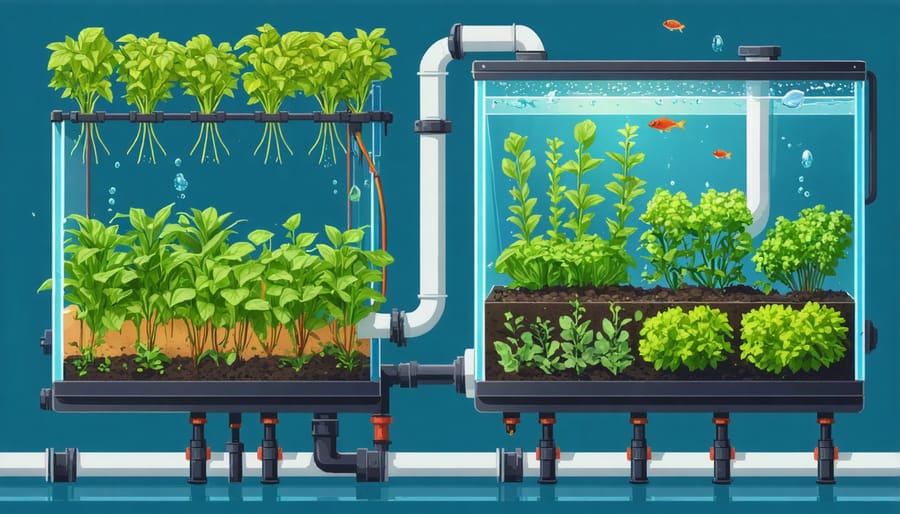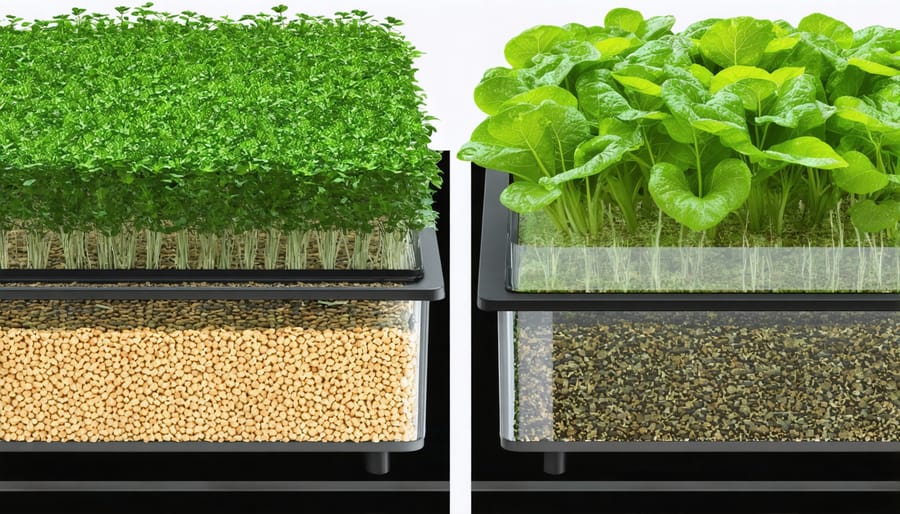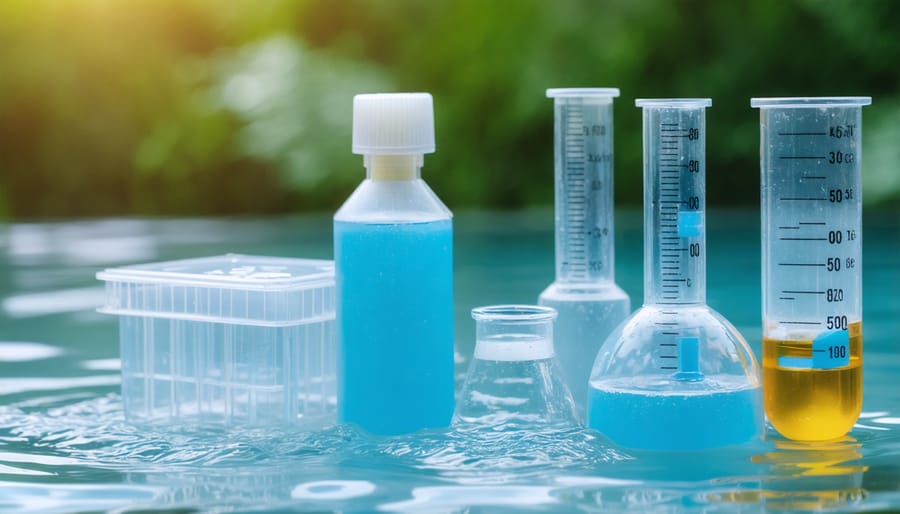
Build a Thriving Aquaponics System: Essential Components That Work Together
Discover the essential components that power a thriving aquaponics system setup, where fish and plants work together in perfect harmony. At its core, every successful aquaponics system combines three vital elements: a fish tank that houses your aquatic livestock, a biofilter teeming with beneficial bacteria that convert fish waste into plant nutrients, and growing beds where your vegetables and herbs flourish. This sustainable ecosystem mirrors nature’s own cycles, creating a closed-loop system that produces both fresh fish and organic produce right in your backyard.
Whether you’re a curious gardener looking to dive into aquaponics or an experienced grower ready to expand your system, understanding these fundamental components is crucial for success. Each element plays a specific role, working together like a well-orchestrated symphony to create an efficient, productive growing environment. Let’s explore how these components interact and what you’ll need to create your own thriving aquaponics system, from basic setups perfect for beginners to more advanced configurations for experienced growers.

The Fish Tank: Heart of Your Aquaponics System
Choosing the Right Tank Size
Selecting the right tank size is crucial for a successful aquaponics system. For beginners, a good rule of thumb is to maintain a ratio of 1:1 between your fish tank and grow bed volume. A 100-gallon fish tank paired with 100 gallons of grow bed space provides a balanced ecosystem that’s manageable for most home setups.
Consider your available space and goals when choosing tank dimensions. A typical home system might start with a 50-100 gallon tank, which can support 15-25 medium-sized fish. For vertical gardens or limited spaces, tall, narrow tanks work well, while wider, shallower tanks offer better surface area for gas exchange and easier fish access.
Remember that larger tanks are more stable and forgiving for beginners, as they resist rapid temperature and pH changes. However, don’t go bigger than you can maintain – a well-managed small system produces better results than a neglected large one. For most home gardeners, starting with a 4×4 foot tank footprint provides enough space while remaining manageable.
Make sure your tank material is food-safe and sturdy enough to hold water long-term. IBC totes, purpose-built aquaculture tanks, or reinforced plywood with pond liner are all popular choices among DIY enthusiasts.
Essential Tank Equipment
To keep your aquaponics system running smoothly, you’ll need several essential pieces of equipment in your tank. A reliable filtration system is crucial for removing solid waste and supporting beneficial bacteria in aquaponics. Most systems use a combination of mechanical and biological filtration to maintain water quality.
Aeration is another vital component – your fish and plants both need well-oxygenated water to thrive. An air pump connected to air stones or diffusers will create bubbles that dissolve oxygen into the water while helping to circulate it throughout your system.
Don’t forget about monitoring equipment! A good quality thermometer is essential, as fish are sensitive to temperature changes. You’ll also want testing kits for pH, ammonia, nitrites, and nitrates. These parameters need regular checking to ensure your system stays balanced. I recommend getting a digital pH meter for accuracy, plus test strips for quick daily checks.
For convenience, consider adding an automatic fish feeder and a backup power supply for your pumps. These extras can be real lifesavers when you’re away or during power outages.
Growing Beds: Where Plants Thrive
Media-Based vs. Floating Raft Systems
When setting up an aquaponics system, you’ll need to choose between two main growing bed types: media-based and floating raft systems. Each has its unique advantages and works best for different situations.
Media-based systems use materials like expanded clay pellets, gravel, or rock wool to support plant roots. These systems excel at filtering waste and providing excellent root support, making them ideal for growing larger plants like tomatoes and peppers. They’re also great for beginners since they’re more forgiving with water flow fluctuations and provide beneficial bacteria with more surface area to colonize.
Floating raft systems, also called deep water culture (DWC), suspend plants in foam boards that float directly on the water’s surface. Their roots hang freely in the nutrient-rich water below. These systems are perfect for leafy greens and herbs, offering faster growth rates and easier harvesting. They’re also more space-efficient and easier to maintain, though they typically require additional filtration.
For home gardeners, media-based systems often prove more versatile and reliable. However, if you’re mainly interested in growing salad greens or herbs, a floating raft system might be your better choice. Many experienced aquaponics gardeners eventually combine both methods to maximize their growing potential.

Best Growing Media Options
The success of your aquaponics system heavily depends on choosing the right growing media for your plants. Expanded clay pebbles (also called LECA or Hydroton) are a popular choice due to their lightweight nature and excellent drainage properties. These round clay balls provide sturdy support for plant roots while allowing plenty of space for beneficial bacteria to colonize.
Another fantastic option is volcanic gravel (scoria), which offers similar benefits to clay pebbles but often at a lower cost. Its porous structure creates the perfect environment for both root development and bacterial growth. For those looking to keep expenses down, river gravel or pea gravel work well too, though they’re heavier and might require stronger support structures.
Coco coir and rockwool are excellent choices for smaller systems, especially for starting seeds. These materials retain moisture well while providing good aeration for young roots. Remember that whatever media you choose should be pH neutral and won’t break down over time in water.
For best results, consider using a mix of different media types. For example, you might use rockwool for seed starting, then transfer plants to clay pebbles for the growing phase. This gives you the benefits of each material at different growth stages.
Plumbing System: Keeping Everything Connected
Pumps and Piping
The heart of your aquaponics system lies in its pumps and piping network. You’ll need two main types of pumps: a water pump to circulate water through the system and an air pump to provide oxygen to both plants and fish. Choose a water pump that can cycle your entire tank volume at least once per hour – for example, a 100-gallon system needs a pump rated at minimum 100 gallons per hour.
For piping, PVC is the most popular choice due to its durability and cost-effectiveness. Use 1-inch diameter pipes for the main lines and ¾-inch for branch lines to prevent clogging and ensure smooth water flow. Install valves at key points to control water flow and make maintenance easier. Don’t forget to include unions and disconnects for easy system breakdown when needed.
When setting up your plumbing, create a slight downward slope in horizontal pipes (about 1 inch drop per 4 feet) to prevent water from stagnating. Always use food-grade materials and avoid metal fittings that could corrode and harm your fish. Remember to secure all connections properly with appropriate PVC cement to prevent leaks.
Water Flow Management
Proper water flow is the lifeblood of any aquaponics system, keeping both your fish and plants healthy. The key is maintaining consistent circulation that moves water from the fish tank through the filtration system and to your growing beds, then back again.
For most home systems, you’ll want to cycle your entire water volume at least once per hour. This ensures adequate oxygenation and nutrient distribution. A good rule of thumb is to choose a pump that can move at least 250 gallons per hour for every 100 gallons of system water.
Setting up the right plumbing configuration is crucial. Use PVC pipes that are one size larger than your pump’s outlet to reduce friction and energy costs. Install valves at key points to control flow rates and make maintenance easier. Consider adding bypass lines for emergencies and cleaning operations.
Keep an eye on water levels and flow rates daily. Reduced flow could signal clogs or pump issues that need immediate attention. Regular cleaning of strainers and filters will help maintain optimal flow and prevent system crashes.
Remember that different plants have different flow needs – leafy greens generally prefer faster flow rates than fruiting plants. Adjust your flow accordingly using control valves for best results.
Monitoring and Control Systems

Water Quality Testing
Regular water quality monitoring is crucial for a healthy aquaponics system. You’ll need to test several key parameters: pH (aim for 6.8-7.0), ammonia (should be near zero), nitrites (also near zero), and nitrates (between 5-150 ppm). Don’t forget to check water temperature too – most fish prefer it between 18-24°C (64-75°F).
Get yourself a reliable testing kit from your local aquarium store. These usually include color-changing test strips or liquid reagents that make testing super easy. Test your water at least weekly when starting out, then you can switch to bi-weekly once your system stabilizes.
Keep a simple logbook to track your readings – this helps you spot trends and catch potential problems early. If any parameters are off, small adjustments with pH-up/down solutions or adding calcium carbonate can usually get things back on track. Remember, happy fish mean healthy plants!
Temperature and pH Control
Maintaining proper temperature and pH levels is crucial for a thriving aquaponics system. Fish and plants each have their ideal ranges, but most systems work best when water temperature stays between 68-75°F (20-24°C). A reliable aquarium heater or chiller can help maintain these temperatures, while shade cloth or greenhouse covering provides additional climate control.
pH levels should typically stay between 6.8-7.0, striking a balance that works for both fish and plants. While fish can tolerate a broader range, plants need this sweet spot to absorb nutrients effectively. Test your water daily using a quality pH meter or test strips, especially when first setting up your system.
To adjust pH naturally, you can add crushed coral or limestone to raise it, or use food-grade vinegar to lower it. Remember to make changes gradually – sudden shifts in either temperature or pH can stress your fish and damage plants.
Setting up an aquaponics system might seem daunting at first, but understanding its core components makes the journey much more manageable and exciting. As we’ve explored, each element – from the fish tank and grow beds to the plumbing and monitoring systems – plays a vital role in creating a thriving ecosystem where fish and plants support each other’s growth.
Remember, successful aquaponics is all about balance. Your fish provide nutrients for the plants, while the plants clean the water for your fish. The pumps keep everything moving, and your monitoring systems help you maintain optimal conditions. It’s a beautiful example of nature and technology working together to create sustainable food production.
Whether you’re planning a small indoor setup or dreaming of a larger backyard system, start small and expand as you gain confidence. Take time to research and understand each component before diving in. Join local aquaponics communities, attend workshops, and don’t be afraid to ask questions. The aquaponics community is typically very welcoming and eager to share knowledge.
Ready to start your aquaponics journey? Begin by sketching your system design, listing the components you’ll need, and setting a realistic budget. With proper planning and care, you’ll soon be growing your own fresh vegetables and raising healthy fish in a sustainable, water-efficient system that brings joy and satisfaction to your gardening experience.
